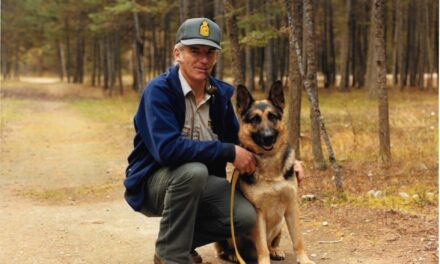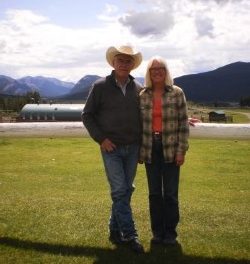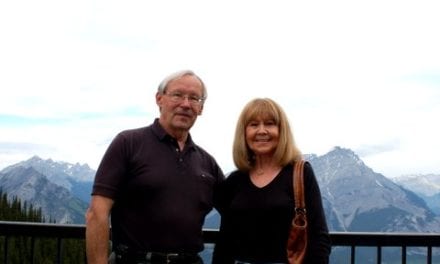I did a lot of research on immobilizing and handling of animals. We brought Dr. Jerry Haig in from the University at Saskatoon to improve our capture and handling methods. I also learned a lot in the national parks in Africa on my winter travels. I was proud to receive a Public Service “Suggestion Award” from Incentive Awards Canada for increasing the safety of bear handling. I spliced 3/16 inch hemp rope into cross-over handcuffs to hold all of the bears feet together. We could also hook into them to weigh the animal. If the bear came out of the drug too soon, or was under-dosed, it could not attack the handlers, because its feet were tied together, and it could not get up. The helicopter sling net had three corners attached to the cargo hook and one corner hooked to the skid. If a bear became conscious in transit the pilot could lower it down and roll it out of the net without needing persons on the ground to remove the net. The bear could simply chew its restraints off and be on its way.
In the early nineties things began to change big time in Banff Park. We were being re-organized! We were shifting to the American model, and I really did not like what I was seeing. Suddenly I had a “supervisor” over me who was calling the shots. I tried to go back to university but I couldn’t comprehend statistics. I thought I was getting it, but when I sat in my statistics exam my brain went blank. There was nothing there. I just stared at this paper for two hours and then I got up and left thinking, I guess I’ll never be able to do statistics. And if you couldn’t do statistics, you couldn’t get a master’s degree in biology. Perhaps I had grown too old and stubborn.
I think most of the older Wardens at the time when I started just had Grade 8, and hardly any of them finished high school. They had real world experience behind them, not academics. I made a quick list of people the people I worked with over the years and still remember; like Henning Sorenson and Bill Glennon in the carpenter shop, really great guys. Ted Stafford in the radio shop, we developed the remote avalanche bombs with him. He transitioned us from the big lunch box radios to smaller and smaller ones. He’d been there when we experimented with bone mics in our helmets for Public Safety and he invented the remote bombs set-up for the Bourgeau slide paths on the way to Sunshine. Louis Trono, was in stores with Ron Leighton. Everybody was afraid of Ron Leighton because he was a big old gruff guy, but with heart of gold. A lot of times we’d end up having drinks Friday afternoon with the carpenters and the guys from stores and they were really fun people to be around. Stan Peyto was over at the garage and if you needed something, he’d find a way to build it for you, or put somebody on to that. Peter Fuhrmann of course and Jim Davies our helicopter pilot. In Yoho I started with the old guys, Fred Dixon, Wally McPhee, Bill Walburger, Andy Anderson and Gordon Rutherford. Gordon was pretty much responsible for establishing the Iceline Trail, which is a trail I do every single summer because it’s a fantastic trail. It should be called the Rutherford Iceline trail. He spent his whole career in Yoho. Then the guys that were here, Cooper, Auger, Everts, Wackerle, Skjonsberg, Monte Rose, Peyto, Jacobson, our area manager Peter Whyte. The crew al Lake Louise; Loewen, Morton, Israelson, McKnight, and the infamous Jimmy Rimmer. One also got to know a lot of people in town: Bud Brewster, Charlie Locke, Ralph Scurfield and Peter Steiner. You interacted with everybody. We had the Ya Ha Tinda with Cal Hayes and Slim Haugen. When one went up there you brought out a bottle of whiskey and Slim would take the cork and throw it away, telling lies for the rest of the evening. You wouldn’t get up until the bottle was gone. Steve Thomas and Herve Sibille, flying trail crew. Cal Hayes ran the Indian trail crew here for a few summers and they did a lot of trail construction, real work, get in there and build stuff. Lance Cooper quit in 1980 to become a helicopter pilot. The last real trail construction in the Park that I can remember was in the mid 1980s when Keith Ostertag and Lance Cooper were graveling trails by helicopter. Egypt Lake got gravel along the trails and a lot of other places, they were slinging in the gravel. That was when there was still a bigger trail crew of people actually dug water bars and stopped the erosion to make the trails last.
MH: What did you like / Dislike about being a warden? 3017:
RK: I liked everything about being a Warden, especially the wildlife stuff. For example, Kootenay, my favorite research bear, that we had collared during the black bear study. We were trapping bears for two or three years, and we were discovering that we didn’t have a lot of black bear habitat. But we trapped bears from Saskatchewan Crossing right up to Mount Coleman. One bear was named Coleman so it means he was trapped at Mount Coleman. Everything we had that was collared, we knew where it was from because it had a significant name. We trapped a wolf when Gaby Fortin was there, as a Chief Park Warden fresh from Quebec. He was very excited to have a wolf named after him. When you talked about the collared animals, you kind of knew who they were. Sludge was a black bear trapped down at the sewer lagoon, eating the sludge. Kootenay was from Kootenay Park. And if you’ve got a bear called Sunshine, well, chances were it was trapped somewhere in the Sunshine area. After I left, they wouldn’t name the critters anymore, because I don’t know why.
They started numbering them, like bear 86 and you’d wonder who the hell is bear 86 and you didn’t have any way to grab a reference point right about the bear. Then we couldn’t write our wildlife notes anymore, because it couldn’t be in the newspaper. It got quite silly. So it was time for me to leave.
The other thing I really liked about being a Warden was that you weren’t sure what you’d be doing day by day. So even though you kind of had a plan, when you got up in the morning and went to work, it could get derailed in a really big hurry because you’d walk into the office and something explosive would be happening. This just flashed me into one of those learning moments where when we’re in public safety. John Wackerle was still doing some of it before he really wrecked his knee, and someone came roaring into the Warden Office, they had an accident somewhere and they were overemotional. John just took him by the hand, back to the coffee room, sat him down, poured him a coffee and he rolled himself a cigarette and said, “Okay, now let’s start at the beginning and get everything sorted out.” John was so cool. He was not rushing off into anything without learning as much as he could find out about this accident, before we mobilized the rescue.
In those days, you could bring people to the coffee room and you could smoke. People walked in and out of the Warden Office. It wasn’t long after I left and I went down there to go for a visit and I couldn’t get in the front door because it was now like the police office. There was a big wall there and the Chief Park Warden’s office was around the corner but you couldn’t get to him. You couldn’t walk in the back door anymore. I got out just in time.
I didn’t like Law Enforcement all that much. And some of the guys bonded with the RCMP members in town, but I just didn’t like that black and white mentality of the enforcement people where there’s no shades of grey, but then I didn’t have to do that much. I have a note here somewhere about I didn’t like the handgun issue but that happened after I left. We always carried rifles. We had the big rifles for big bears and shotguns for immobilizing. The RCMP didn’t care if we used a sidearm for close up work immobilizing bears. Some of us did. I didn’t think side arms were an issue, and I didn’t want to get involved in domestic arguments in the campground.
They made a really big deal out of that and how important being on top of law enforcement was having a sidearm and body protection. There was a real mess, with the RCMP taking over law enforcement in the Park temporarily. We had a lot of ridiculous stuff with the firearms and the rifles. Mind you, they had the poaching incident that happened somewhere around that same time. Dave Butler, from Cranbrook wrote a couple of books about poaching cases. Starring a Jenny somebody Park Warden heroine, modeled after the Shipsey poaching case.
Things started to change even more after the early 90s, when the Parks started to get Americanized and specialized in everything.
MH: What were some of your more memorable events as a Warden? 3800:
RK: Things like being able to go to Mount Steel for high altitude training in 1977 with Willi Pfisterer. Tim Auger, myself, Derek Tilson from Waterton, Tom Davidson, Darro Stinson and a few other guys from Jasper and Riding Mountain were there. It was a great three weeks up in the Yukon. We were stormbound on Mount Steel for a few days but it was a real highlight to go up that high, almost 18,000 feet. I was glad I wasn’t along when Timmy Auger was on Mount Logan and got caught in an avalanche with Peter Perren. Auger had nine lives. He broke his leg numerous times.
Well, Kootenay, my favorite bear, I mean that was the highlight of my career really, being able to bring him in from Radium Hot Springs back in 1986. He wandered the Bow Valley and around town and didn’t have a mean bone in his body. There were times when he knew that I had something on my mind and he just would not cooperate, and other times, he would totally cooperate. In those days, we were going around picking up bear scats trying to figure out what they were eating. But with Kootenay we just had to fallow behind, and watch what he was eating. It made sense to watch what was going in, rather than examine what came. He was great, we’d be down at the golf course and Kootenay would go from juniper bush to juniper bush, he knew where all the berry bushes were and where the buffalo berries were as well. One of the neat things of having that research program on the go over the years was that the contractors were smart enough to plot the movements on the computer. We could see how the bears moved seasonally. For three years Timberline (the bear), never went down Brewster Creek. Then we had a berry crop failure in the Bow valley and she just went down Brewster Creek into this tremendous berry patch that I guess her mother had shown it to her years before, it was logged in the GPS in her head. She was just doing buffalo berries like crazy. Most of those black bears were approachable. Everybody in town knew about them. I was really sad to see that whole “Wildlife Notes” discontinued because Hubert Green, the generation before me, used to write for the paper and stuff and everybody in town remembered Hubert Green and the stories of the animals that kind of only watched out for them. They didn’t get all fussed and excited just because an elk was in their backyard. I thought, you know, we have too many elk in town, we’ll give the kids slingshots. They don’t have to shoot at all the elk, they will quickly learn which is the lead cow and put their little biodegradable gravel in their slingshot and keep the elk moving. The elk will go and graze where they are not being harassed. But that was too simple of a solution.



